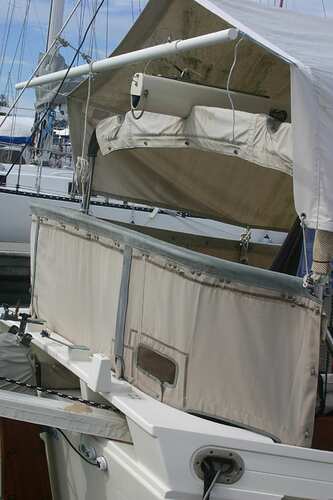In tropical climes, we run with the off watch sleeping in the cockpit - without any modification to the cockpit grate. As you wrote, that meant that the off-watch is immediately available in case of squall, doubts about collision risk, etc.
Zygote has removable insect screens for her skylight hatch and main hatch, with of course fixed insect screens in the dorade vents.
Zygote has a full enclosure for the cockpit. I’ve uploaded photos of it before (see http://www.samlmorse.com/forum/read.php?5,4450,5194#msg-5194). We often run in rainy conditions with the awning and the aft curtain in place. The two side curtains were designed, by Bob Baltierra, so they flop down and hang inside from the wind curtains. The side curtain are then easy to fix in place to deal with a rain squall.
We’re living aboard in the marina now and have just weathered an East Coast Low that dumped considerable rain (183 mm or 7 inches of rain in 24 hours, according to Brisbane weather: Wettest May day in 175 years). Before the ECL arrived, we dropped our usual Sunbrella awnings and installed the cockpit enclosure - that ensures that the cockpit remains as protected living space, meaning that the cockpit becomes both a mud room (for donning, removing, and drying foul weather gear) and living space.
I reckon that making side curtains to the wind curtains is preferable to just making side curtains to the coamings. More space is enclosed and you can grind the primary sheet winches unhindered.
We’ve lived aboard in the tropics much of the past 15 years and not bothered about insect screens in the cockpit. But we’ve not been in locations notorious for no-see’ums and the like, just places with mosquitoes known to be carrying dengue, chikungunya, and Q fevers.
Bob Baltierra also designed and made small forward curtains, running from the side curtains to the dodger, with apertures for the sheets and the roller reefing line, so the full enclosure is “full”. You can see the starboard forward curtain on the Zfullenclosefront image.
Bil

